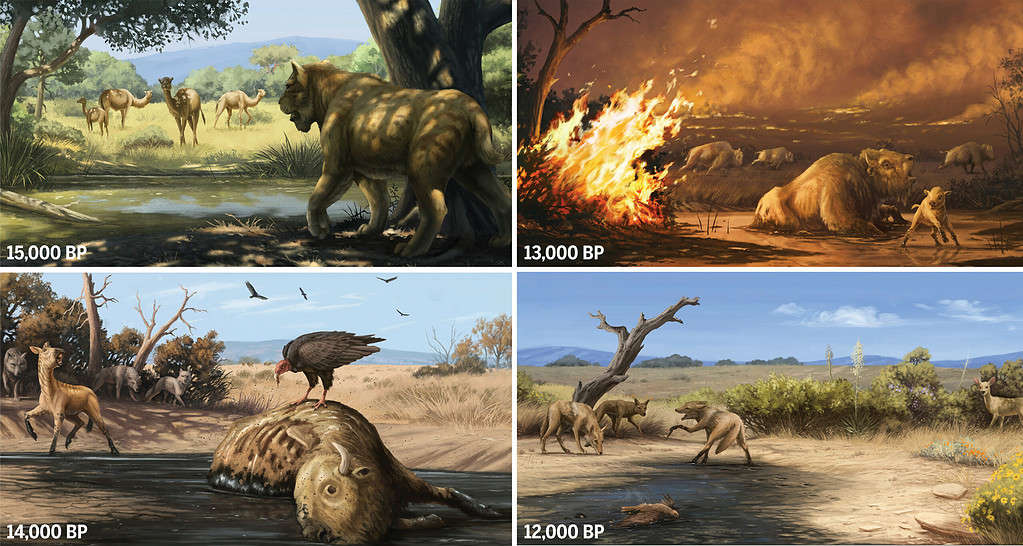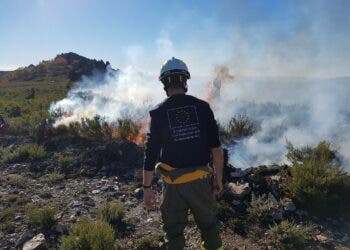If you were to go back in time 140 centuries, to California, you’d come across some pretty iconic creatures. Giant animals, from sloths to saber-toothed cats, roamed the land, and humans were just coming in. However, in just 1,000 years, everything changed. All these animals were gone and the landscape had radically changed.
Researchers have known for some time that this happened — the fossil evidence is clear enough. But why exactly it happened is not equally clear. Now, a new study offers a plausible explanation: fire.

A team of researchers looked into the region’s archaeological and biological evidence, looking for clues as to what drove this extinction. They found that around this extinction’s period, large-scale fires were ravaging an ecosystem that was already under threat from climate change and human impact.
The timing fits very well. Some 14,000 years ago, temperatures in the northern hemisphere started to increase. It was also around the time when humans reached North America and were looking to establish themselves on top of the food chain.
In fact, the situation was very similar to what’s happening now.
“The conditions that led to the end-Pleistocene state shift in Southern California are recurring today across the western United States and in numerous other ecosystems worldwide,” the authors wrote. “Understanding the interplay of climatic and anthropogenic changes in driving this past extinction event may be helpful.”
The answer’s in the tar
About two-thirds of Earth’s large mammals, from mammoths to mastodons, went extinct in North America at the end of the last Ice Age. This coincided with changes in the climate and the growth and expansion of human populations. However, while researchers have a good idea of what happened, they don’t know exactly how things went down.
Much of what we know comes from fossil evidence. But fossil evidence is sparse and imprecise at these timescales. So, researchers were looking for another source of information — and they found it in the La Brea Tar Pits near Los Angeles in California.
Tar pits are an unusual and effective means of preserving the remains of organisms, often leading to well-preserved fossils. It works like this:
- Trapping Mechanism: Tar pits are pools of heavy, sticky asphalt that can trap animals, plants, and other organic matter. When an animal becomes trapped in a tar pit, it may attract predators and scavengers, which can also become trapped. This leads to the accumulation of various organisms in one location.
- Anoxic Environment: The dense, sticky nature of the tar excludes oxygen. This anaerobic environment slows down or stops the decay of organic matter by bacteria.
- Preservation of Soft Tissues: Many fossilization processes only preserve hard parts like bones, teeth, and shells. In tar pits, the lack of oxygen and the enveloping nature of the tar can sometimes lead to the preservation of soft tissues.
- Protection from Scavengers and Physical Weathering: Once an organism is enveloped in tar, it is protected from scavengers that might otherwise scatter or consume the remains. The tar also provides a physical barrier that shields the remains from weathering and erosion.
- Sediment Accumulation: Over time, layers of sediment can build up over the tar, encapsulating the organisms in a stable environment. This additional layering further aids in preservation by adding pressure and protection.
- Continuous Record: Tar pits can trap organisms over long periods. This means they may provide a continuous or semi-continuous record of the organisms living in an area over time. This can be invaluable to paleontologists looking to understand the ecology and evolution of past environments.
- Ease of Discovery: The nature of tar pits makes them relatively easy to spot. Bones and other remains may partially stick out of the pit or are found near the surface. This can make the discovery of fossils more straightforward than in other geological contexts where extensive digging and careful extraction are required.
The La Brea Tar Pits site is an excellent example. It contains a nearly continuous record of megafauna from over 55,000 years ago to the Holocene, 12,000 years ago. Using over 160 bones from seven different animals, the researchers looked at the timing and cause of extinction of the animals that once got stuck in the tar and compared this with charcoal records.
Fire and extinction
They found that mammal populations in southern California were steady from 15,000 to about 13,250 years ago. Then, there was a sudden plunge in the animal populations with all becoming extinct around 13,000 years ago. This extinction event matches a change in the environment, marked by warming and fires.
The charcoal records show that wildfires started growing 13,500 years ago and peaked between 13,200 and 12,900 years ago.
Humans arrived on the US Pacific coast 16,000 to 15,000 years ago and lived alongside the megafauna for 2,000 to 3,000 years until these animals went extinct — and in all likelihood, this may be no coincidence, with humans playing a major role in the mass extinction. Helped by the changing climate that made vegetation dry, humans could have started some of the fires themselves in order to drive out animals and make them easier to hunt. As humans hunted herbivores this left even more vegetation to burn.
“Fire is a way that small numbers of humans can have a large impact over a broad area,” Michael Waters, one of the study authors, said in a news release. “This study has implications for the changes we see in southern California today. The temperatures are rising, and the area is drying. We also see a dramatic increase in fires.”
The researchers argue that the study’s findings show that history may be repeating itself. The challenges faced by the megafauna in the last ice age ring true to what is now happening across ecosystems. The global average temperature has already gone up by 1.1 degree Celsius, which combines with big landscape transformation due to human activities.
The study was published in the journal Science.






